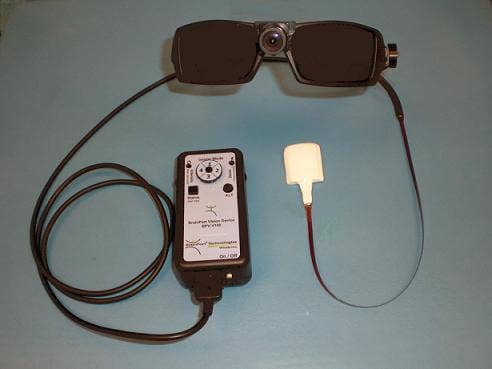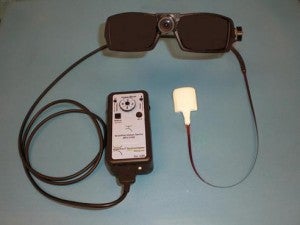Brainport Lets The Blind See With the Tongue (Video)

Share

Put on the glasses, adjust the dials, put the white thing in your mouth...and presto! You can see with your tongue.
Part of the reason I love my job is that I get to see things that I would never have dreamed of or even believed. Case in point: using your tongue to see instead of your eyes. Wisconsin based Wicab, Inc. has invented Brainport Vision, a device that stimulates the tongue with electric pulses. These pulses, mild enough that users say they feel like "champagne bubbles", paint an electric picture in the mouth. Much like pixels on a computer screen, the electrodes in Brainport Vision vary in intensity to convey an image taken from a camera. The end result is that a blind person can learn how to 'see' by feeling the electric picture stimulated onto their tongue. It sounds crazy and it is. But it works. Don't believe me? Check out the video after the break. Erik Weihenmayer, a blind tester for Brainport Vision, plays tic tac toe, reads words, and climbs a rock wall. Seriously.
Humans have a large portion of their brain dedicated to interpreting visual images. Even when the eyes, or other part of the sensory system, is damaged, often the visual cortex of the brain lives on. So you have all this dedicated processing power but nothing to compute. Some Brainport Vision testers have actually shown activity in the visual processing portions of their brain while using the device. What does this mean? Not really sure. Certainly it gives hope to the blind that they will be regain some sense of vision even if it is fundamentally different from the traditional sense most others experience. But it also hints at the flexibility of the human brain and suggests there are many more ways it could be adapted to compensate for trauma and illness.
Be Part of the Future
Sign up to receive top stories about groundbreaking technologies and visionary thinkers from SingularityHub.


Did you watch the video? Did you see Erik Weihenmayer read "Dad" using what looks like a fancy tongue depressor? That's the Tongue Display Unit (TDU), which has an array of electrodes (between 100 and 600 depending on the testing unit) that stimulate the tongue in a 3cm by 3cm area at 30 frames per second. The head mounted camera that Erik wears conveys a grayscale image to the base unit that he wears around his waist. There, the digital image is converted into a simpler (more pixelated) picture that is sent to the TDU. The whole process is nearly instantaneous, but interpreting the image takes some time.
Surprisingly, Brainport Vision doesn't take as long to master as one would think. While training takes around 2-10 hours, testers are typically able to start to interpret images in a matter of minutes. Those images are fairly primitive right now - 100 to 600 points of information makes for a very blurry picture. Wicab, however, has plans to raise the resolution and early tests suggest that the tongue has plenty of sensitivity to support up to (perhaps beyond) 3600 points of electric stimulation. At that resolution, the 'vision' that Brainport provides could be pretty close to what a sighted person sees. Training may take longer at that point, but it would certainly seem worth it.
Those with impaired vision may be interested in getting a tongue on Brainport Vision but it's still a "investigational device". That means that is lacks the US FDA approval for sales and some forms of trials. There are limited programs to test the Brainport device at Wicab's home office in Wisconsin, the University of Pittsburgh, and Lighthouse International in New York. Those interested in participating can contact Wicab through their website.
In some ways, Brainport Vision is a perfect tool for the blind. It's non-surgical, non-invasive, and users can easily upgrade to next generation devices as they are developed. Yet Wicab has clearly stated that they believe Brainport will serve chiefly as an augmentation to canes, guide dogs, and other traditional tools for the vision impaired. It isn't meant to fully restore sight to the blind. But watching Erik Weihenmayer play with his daughter, read, and climb a frickin' wall, I'm inclined to believe that a future version of Brainport could be much more. Of course, not everyone will want to shock their tongue in order to see. There's no telling if Brainport will ultimately be successful and achieve widespread adoption. Still, seeing with your tongue? That's some amazing and nutty science. I love this job.
[photo credit: Wicab, Inc]
Related Articles

This Portable Wind Turbine Is the Size of a Water Bottle and Charges Devices in Under an Hour

Mojo Vision’s New Contact Lens Brings Seamless Augmented Reality a Step Closer
The Weird, the Wacky, the Just Plain Cool: Best of CES 2020
What we’re reading